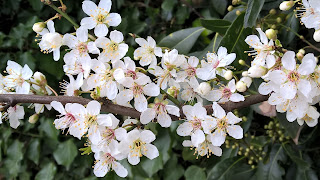The Flowering Blackthorn
Like its lighter and beloved sister, the Hawthorn, who is said to
rule over the light half of the year, Blackthorn has long been associated with
Faeries, Witches and Magic. Blackthorn is often considered a darker, more
sinister tree than its sister and it rules over the darker winter months for
this is when it is in its element. At the start of winter the Blackthorn
produces its wonderful deep blue/purple/black sloes and as winter ends the
trees explode in ghostly white blossom. With its rich nectar and pollen, it is
a lifesaver for many foraging insects, like bees, for whom there is little else
at that time of year. With its shrubby
and dense nature, along with the Hawthorn, Blackthorn is a vital component of hedgerows which provide refuge and food
for many birds, insects and small animals as well as the Fae.
The contrast between the dark thorny stems and the beautiful white
flowers is stark, rather like the contrast between the light of the moon and
stars and the darkness of the cosmos. In moonlight the flowers seem to even
radiate their own silvery light. Blackthorn is a tree of duality as it is
linked with both healing and death. Parts of the tree were used to treat
fevers, make a strong red dye, make a healing tea, or flavour gin. Its thorns
were used to make weapons such as the Irish shillelagh (‘cudgel/walking stick’) which was also
used as a weapon and pins of slumber - blackthorn thorns coated
with poison. It was on one such pin of slumber that Sleeping Beauty pricked
herself and promptly fell asleep for a hundred years. Interestingly the average
lifespan of a Blackthorn is also said to be around a hundred years...
Folklore
tells us that a particular type of Faerie is linked with the Blackthorn - the
Lunantishee. The name refers to Luna - the Moon and the Shee - an Irish term
for the Faeries. The Lunantishee are said to worship the moon and dance around
their host Blackthorn tree or bush by the light of the full moon. The best
description of the Lunantishee comes from The Fairy Faith in Celtic Countries by W.Y. Evans-Wentz; in it an Irish farmer
called Patrick reported “The Lunantishee are the tribes that guard the
blackthorn trees or sloes; they let you cut no stick on the 11th of
November [old Samhain], or on the 11th of May [old Beltane]. If at
such a time you cut a blackthorn, some misfortune will come to you.”
With its five petalled flowers, so
reminiscent of the Pentagram of Wicca and Witchcraft, the Blackthorn is a tree
of the Goddess in her darker forms such as Ceridwen who brewed the magical herbal
potion of inspiration or Awen in her giant cauldron and the Cailleach, a Faerie
Queen of Winter, who is said to have a
transforming staff of Blackthorn with
which she blasts the land of all life at Samhain. To bring Spring Brighid (some say
that Brighid is the Summer face of the Cailleach while others see than as two
separate Goddesses who each rule a half of the year) touches the land with her
own staff of Hawthorn or Birch, which brings the land back to life. At this
point not even the dark, wintery Blackthorn can fight the return of Spring and
it flowers, even before it comes into leaf.
Witches wands and staffs were
traditionally said to have often been made of Blackthorn and it does produce a
gorgeous fine grained, yet tough and hardwearing wood. Major Thomas Weir, A
Scottish Witch burned for his craft in 1970 famously had a staff of Blackthorn,
carved with a Satyr's head, which he could use as a broomstick to fly through
the air. His staff was burned alongside him and allegedly performed "rare
turnings" as it burned. His ghost is still said to carry the staff as he
haunts the West Bow district of Edinburgh.
The smell of Blackthorn flowers is
quite potent and supposedly brings about desire, as with Marmite people seem to
either love the smell or despise it. Along with Hawthorn flowers, Blackthorn
flowers were placed in bridal bowers because of their associations with
fertility. When steeped in water or boiled down into a concoction the flowers have
traditionally been used to make healing tonics, mouthwashes, gargles for those
with coughs, colds or tonsillitis, perfumes,
eye washes, as well as for their diuretic and laxative properties.
The Blackthorn reminds us of the natural
cycle of life, death and rebirth. The flowering of the Blackthorn is a magical
and blessed sight and rebirth after the death and darkness of winter. It
reminds us of hope, of the light in the darkness, of the light of the stars
that guide our way, the light at the end of the tunnel and of nature's power of
transformation. Like the Blackthorn we too long to blossom and come out of our
wintery indoor shells as the world around us starts to brighten and warm up.
If you would like to know more about
the Blackthorn or about Faeries and Trees, please do check out my book - Faerie Forest: An Exploration of the Folklore and Faeries Surrounding Seven Magical Trees.
If you would like to grow your own Blackthorn in your garden, and it is a great addition for any Nature Garden, the Woodland Trust sell Native British Blackthorns, all sourced and grown in the UK, and your purchase will support their invaluable work - http://www.woodlandtrustshop.com/products/222-blackthorn-trees.aspx
If you would like to grow your own Blackthorn in your garden, and it is a great addition for any Nature Garden, the Woodland Trust sell Native British Blackthorns, all sourced and grown in the UK, and your purchase will support their invaluable work - http://www.woodlandtrustshop.com/products/222-blackthorn-trees.aspx



Comments
Post a Comment